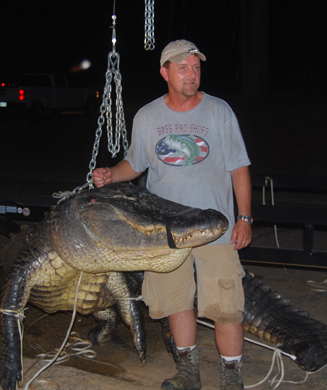





Fancher admits he didn't have a clue as how to hunt gators when he drew the tag. "I was lost. I had heard my cousin talk about it and knew he had been a few times before, but I didn't know what to expect," he said. He and Peeples hit the Alabama River a few times in the weeks leading up to the hunt. Part of this was just to learn how to navigate it, since the hunt would take place at night. "We saw a lot gators in the 6- to 10-foot range, but most of the time was spent down there learning the river and trying to find some good-looking spots to go," said Fancher. During scouting they encountered an alligator they estimated went 12 feet in length. It was 10 miles upriver from the launch and became the original target of the crew. En route to their prey, the party encountered and boated a couple of smaller 6-foot alligators but ultimately released them.




With a crowd of about 60 people looking on, conservation officers stretched the measuring tape and cables on the scale to come up with the record-setting digits. "He was a big animal. There's not much else you can say and not many other words you can use but B-I-G!" said District 3 wildlife biologist Chris Cook. "The girth of the animal was what was most impressive. How big he was. Just his girth around the gut, the head, the tail – it was obvious that he was going to weigh more than anything I've ever seen." Cook says the goals of the hunt were: one, give hunters an opportunity to take alligators and, two, to reduce the number of nuisance alligator complaints in the area. An increase in weekend fishing camps and full-time residents has led to more alligator-human conflict, with some gators becoming accustomed to humans and hanging around boat piers and other areas frequented by residents, raising concern for the safety of pets, children and others. The biologist also mentioned that big gators were expected. "It was the first gator hunt in that area so we figured there would be some big ones coming in. You'd expect it this first year," he said. "Most of them were killed in the middle of the river after coming out of the creeks and backwaters. It was just a matter of riding around, looking and finding the right one." In addition to the Fancher's record-setting 838 pounder, there was a 720-pound alligator taken the next night from the main river channel. "That 720 pounder came in the next night and it was a real big one – and it had a big piece of tail missing or it would have gone over 13 feet," said Cook.



Monster Killer
Gator Girl
The Great Gator Hunt
It took Keith Fancher and six buddies about seven hours to fight and transport this state record alligator. It weighs more than 838 pounds and measures more than 14 feet.

